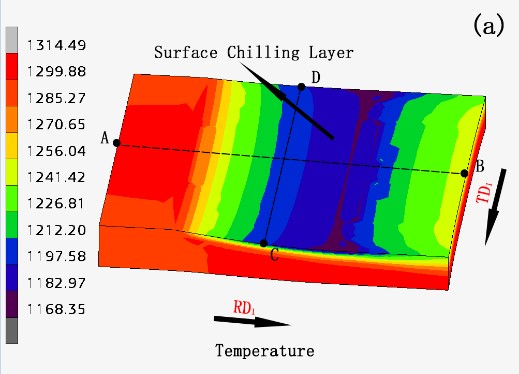
根据以上本构回归开发了纯钼应变补偿形式的数值模型材料库,并通过大型通用有限元仿真平台MSC.Marc 2014对纯钼常见的单向热轧(UHR)与交叉热轧(CHR)两种工艺进行模拟对比,分析其轧制变形区温度场差异化,并用附加应力/应变场量解释等效场量形成客观原因。红外高温计测量板表面温度以提高模型温度场精度。最后着重研究不同加工参数对表面激冷层深度、宽向附加拉/压应力以及轧向塑性应变的影响。验证试验部分:经金堆城钼业股份有限公司制得的钼板坯(初始平均晶粒尺寸约为:24 μm)尺寸为:13.2 × 50 × 100 mm,2个。在氢气气氛保护的加热炉内均加热到1320 °C并达到均匀化。
Based on the above constitutive regression, a numerical model material library in the form of strain compensation for pure molybdenum was developed, and the two common unidirectional hot rolling (UHR) and cross hot rolling (CHR) The two processes are simulated and compared to analyze the difference of the temperature field in the rolling deformation zone, and the additional stress/strain field is used to explain the objective reason for the formation of the equivalent field. The infrared pyrometer measures the surface temperature of the board to improve the accuracy of the model temperature field. Finally, the study focuses on the influence of different processing parameters on the depth of the surface chilled layer, the additional tensile/compressive stress in the width direction and the plastic strain in the rolling direction. Verification test part: The size of the molybdenum slab (initial average grain size: approximately: 24 μm) prepared by Jinduicheng Molybdenum Industry Co., Ltd. is 13.2 × 50 × 100 mm, 2 pieces. In a heating furnace protected by a hydrogen atmosphere, they are heated to 1320 °C and homogenized.